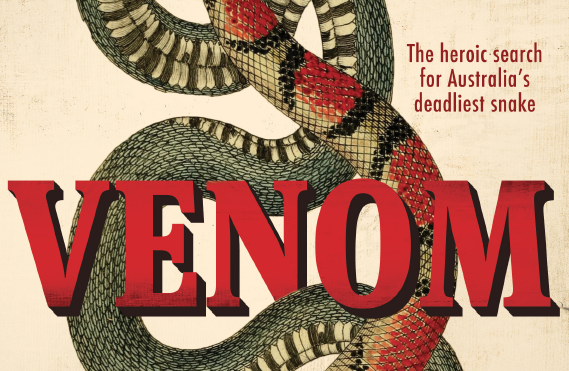
In the first half of the twentieth century, the Australian media began spreading tales of a huge, lightning fast species of snake that was seemingly taking lives at a rate of knots. Attaining a near mythical status, the nguman, or taipan, was all too real. The press demonised them, wary farmers hunted them, and desperate herpetologists tried to capture them, creating the climate of near hysteria that forms the backbone of Venom, the second book from Australian writer Brendan James Murray.
Three core narratives drive this non-fiction: George Rosendale, an Guugu Yimithirr teen bitten in 1949; Bruce Stringer, aged 10, bitten in 1955; and the members of the Australian Reptile Club, trying to capture a live taipan specimen in the intervening years. Murray moves from one to the other, with a few more side stories in between, making for a delightfully frustrating read, as the reader waits anxiously for the snake catchers to bag a much-needed live specimen, for scientists and doctors to pin down an antivenom, and (maybe a little morbidly) for another taipan attack.
And who’d have thought a book about coastal taipans could hit someone so hard in the feels? But that’s exactly what Venom, packed with research and simply stunning writing from Murray, does. The image of cars roaring to light the runway for a plane bringing emergency supplies to a dying Rosendale will stay with me for a very, very long time, and is just one example of the surprising moments of emotion and humanity that elevate this book past its natural history origins. It’s a story filled with excitement, sadness, and nervous tension, as various people around the country come into contact with these elusive, but highly defensive, animals, often with tragic consequences.
But there’s more to this than venomous reptiles and snake bite death sentences. Murray also teases out strands of the various narratives that point to the Europeans’ discrimination against and dehumanisation of the Indigenous population. From the 19th century naturalists taking Aboriginal bodies as specimens for museum display, to the animal-like language used to describe Rosendale in newspaper reports (taking care to never use his name), there’s a clear link between the reptilian menace and the Aboriginal people themselves – once upon a time lumped in with the flora and fauna making life difficult for the white settlers. The irony is, of course, that the taipan might have been identified much sooner if those early cataloguers of the Australian landscape had taken advantage of local knowledge and simply asked – something certainly proven by the help given to later hunters such as Roy Mackay and Kevin Budden.
Venom serves up a distinctly Australian slice of non-fiction, drawing parallels between the natural and social histories so firmly tied to the country. Combining thoughtful writing with almost thriller-like pacing, and packed with extensive and excellent research, the book also reveals a surprisingly emotional side, as driven science meets very human grief.
Come for the snakes, and stay for the story – it’s a really bloody good one!
Brendan James Murray‘s Venom is published by Echo and is available now.
———-
